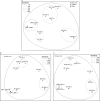Investigating microbial eukaryotic diversity from a global census: insights from a comparison of pyrotag and full-length sequences of 18S rRNA genes
- PMID: 24814788
- PMCID: PMC4068655
- DOI: 10.1128/AEM.00057-14
Investigating microbial eukaryotic diversity from a global census: insights from a comparison of pyrotag and full-length sequences of 18S rRNA genes
Abstract
Next-generation DNA sequencing (NGS) approaches are rapidly surpassing Sanger sequencing for characterizing the diversity of natural microbial communities. Despite this rapid transition, few comparisons exist between Sanger sequences and the generally much shorter reads of NGS. Operational taxonomic units (OTUs) derived from full-length (Sanger sequencing) and pyrotag (454 sequencing of the V9 hypervariable region) sequences of 18S rRNA genes from 10 global samples were analyzed in order to compare the resulting protistan community structures and species richness. Pyrotag OTUs called at 98% sequence similarity yielded numbers of OTUs that were similar overall to those for full-length sequences when the latter were called at 97% similarity. Singleton OTUs strongly influenced estimates of species richness but not the higher-level taxonomic composition of the community. The pyrotag and full-length sequence data sets had slightly different taxonomic compositions of rhizarians, stramenopiles, cryptophytes, and haptophytes, but the two data sets had similarly high compositions of alveolates. Pyrotag-based OTUs were often derived from sequences that mapped to multiple full-length OTUs at 100% similarity. Thus, pyrotags sequenced from a single hypervariable region might not be appropriate for establishing protistan species-level OTUs. However, nonmetric multidimensional scaling plots constructed with the two data sets yielded similar clusters, indicating that beta diversity analysis results were similar for the Sanger and NGS sequences. Short pyrotag sequences can provide holistic assessments of protistan communities, although care must be taken in interpreting the results. The longer reads (>500 bp) that are now becoming available through NGS should provide powerful tools for assessing the diversity of microbial eukaryotic assemblages.
Copyright © 2014, American Society for Microbiology. All Rights Reserved.
Figures




Similar articles
-
Eukaryotic richness in the abyss: insights from pyrotag sequencing.PLoS One. 2011 Apr 4;6(4):e18169. doi: 10.1371/journal.pone.0018169. PLoS One. 2011. PMID: 21483744 Free PMC article.
-
Estimating Protistan Diversity Using High-Throughput Sequencing.J Eukaryot Microbiol. 2015 Sep-Oct;62(5):688-93. doi: 10.1111/jeu.12217. Epub 2015 Apr 25. J Eukaryot Microbiol. 2015. PMID: 25851049
-
Rapid shifts in the structure and composition of a protistan assemblage during bottle incubations affect estimates of total protistan species richness.Microb Ecol. 2011 Aug;62(2):383-98. doi: 10.1007/s00248-011-9816-9. Epub 2011 Mar 4. Microb Ecol. 2011. PMID: 21373815
-
Ultrasequencing of the meiofaunal biosphere: practice, pitfalls and promises.Mol Ecol. 2010 Mar;19 Suppl 1:4-20. doi: 10.1111/j.1365-294X.2009.04473.x. Mol Ecol. 2010. PMID: 20331766 Review.
-
Exploring the environmental diversity of kinetoplastid flagellates in the high-throughput DNA sequencing era.Mem Inst Oswaldo Cruz. 2015 Dec;110(8):956-65. doi: 10.1590/0074-02760150253. Epub 2015 Nov 24. Mem Inst Oswaldo Cruz. 2015. PMID: 26602872 Free PMC article. Review.
Cited by
-
Balechina and the new genus Cucumeridinium gen. nov. (Dinophyceae), unarmored dinoflagellates with thick cell coverings.J Phycol. 2015 Dec;51(6):1088-105. doi: 10.1111/jpy.12346. Epub 2015 Oct 19. J Phycol. 2015. PMID: 26987004 Free PMC article.
-
IM-TORNADO: a tool for comparison of 16S reads from paired-end libraries.PLoS One. 2014 Dec 15;9(12):e114804. doi: 10.1371/journal.pone.0114804. eCollection 2014. PLoS One. 2014. PMID: 25506826 Free PMC article.
-
Molecular characterization and phylogeny of Linguatula serrata (Pentastomida: Linguatulidae) based on the nuclear 18S rDNA and mitochondrial cytochrome c oxidase I gene.J Vet Med Sci. 2017 Feb 28;79(2):398-402. doi: 10.1292/jvms.16-0508. Epub 2016 Dec 11. J Vet Med Sci. 2017. PMID: 27941305 Free PMC article.
-
Regime Shifts in Microbial and Water Quality Dynamics in Red Tilapia Ponds.Microorganisms. 2025 Jul 2;13(7):1553. doi: 10.3390/microorganisms13071553. Microorganisms. 2025. PMID: 40732062 Free PMC article.
-
Environmental selection and advective transport shape the distribution of two cyst-forming Acantharia clades in the Canadian Arctic.J Plankton Res. 2024 Oct 4;46(6):542-554. doi: 10.1093/plankt/fbae051. eCollection 2024 Nov-Dec. J Plankton Res. 2024. PMID: 39664261 Free PMC article.
References
Publication types
MeSH terms
Substances
LinkOut - more resources
Full Text Sources
Other Literature Sources
Molecular Biology Databases

